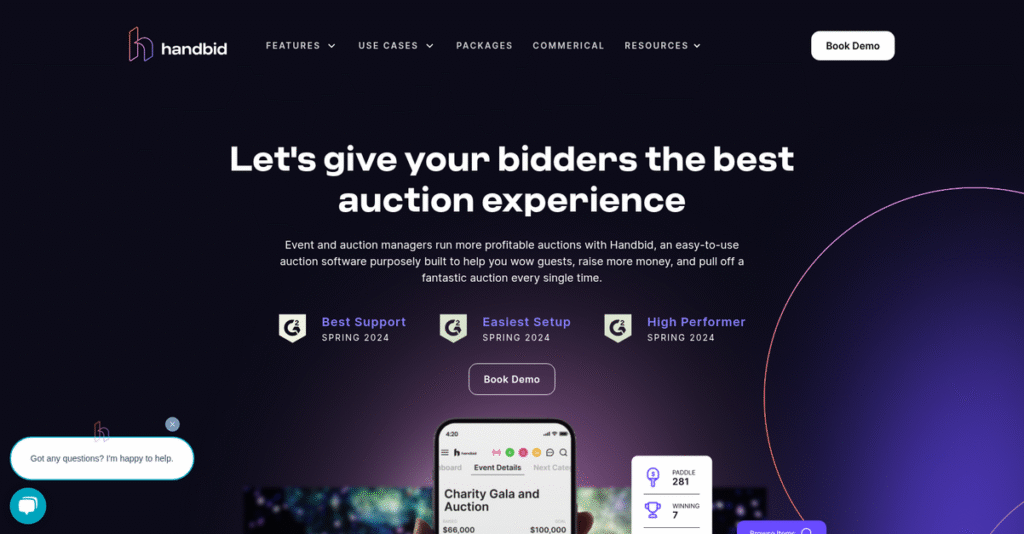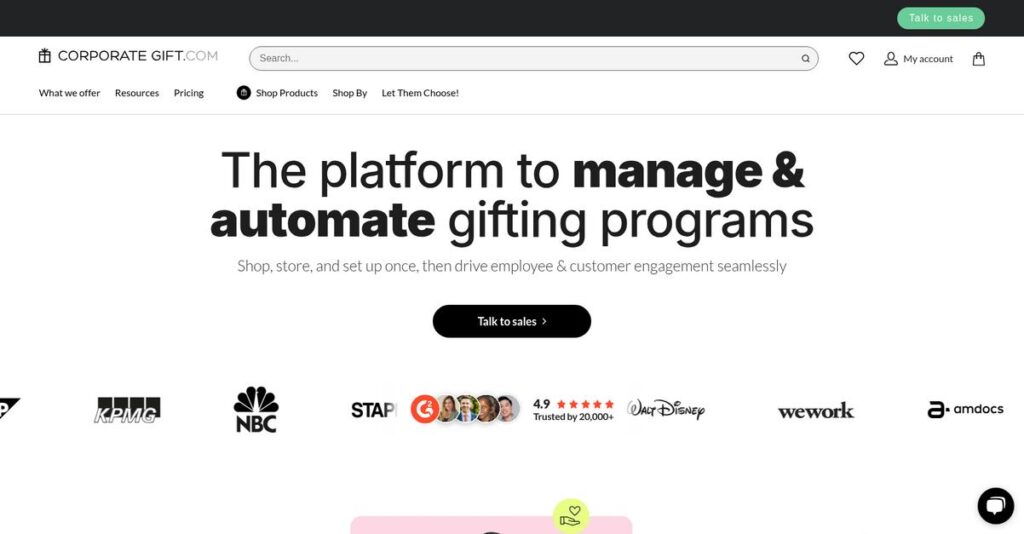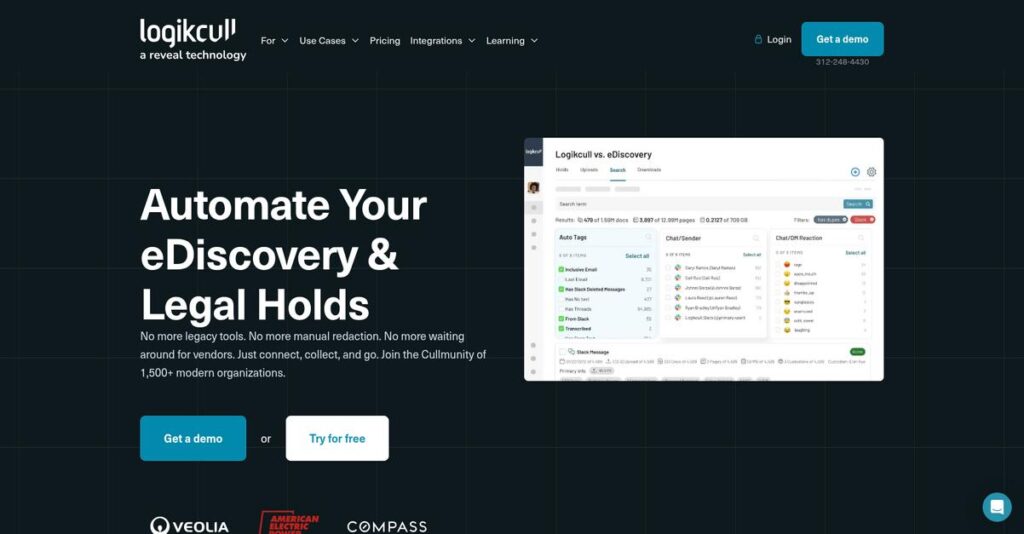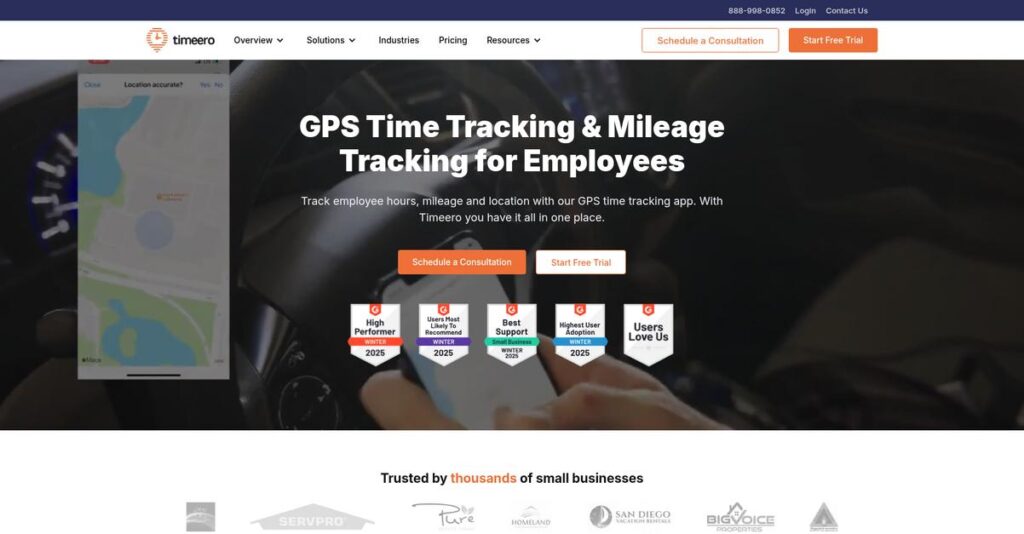Managing auctions with paper bid sheets is exhausting.
If you’re running fundraising events, you know how manual processes, missed bids, and chaotic check-ins can drain your team’s time. That’s likely why you’re digging into whether Handbid can actually fix these problems.
After evaluating Handbid’s platform, my research shows most organizations lose out on real fundraising revenue by juggling disconnected tools or outdated methods.
Handbid tackles this with an all-in-one fundraising event solution, combining mobile bidding, ticketing, peer-to-peer campaigns, and even live streaming. From what I discovered, their system emphasizes ease for both you and your donors, helping you raise more with less stress.
In this review, I’ll explain how Handbid streamlines every piece of the fundraising process so you can see if it fits your needs.
In this Handbid review, you’ll find detailed breakdowns of features, pricing, must-know limitations, and how it compares to other options you might be considering.
You’ll come away with clear insights on the features you need to boost your next fundraiser and the confidence to choose the right software.
Let’s get started.
Quick Summary
- Handbid is a fundraising platform that simplifies silent auctions, live events, and ticketing for non-profits and schools.
- Best for small to mid-sized organizations running annual galas or hybrid fundraising events.
- You’ll appreciate its intuitive mobile bidding app combined with highly responsive customer support.
- Handbid offers tiered annual subscriptions plus transaction fees and personalized demos, with no free trial available.
Handbid Overview
Handbid has been around since 2011, based in Colorado. What impressed me during my research is their clear mission: helping nonprofits maximize fundraising with purpose-built event technology.
What sets them apart is their dedicated focus on small to mid-market nonprofit events. They aren’t a complex enterprise system, which keeps their solution accessible and highly focused for your critical annual gala or auction.
Key developments have expanded their platform far beyond just auctions to include live streaming and peer-to-peer tools. This Handbid review explores how these new capabilities actually work together.
- 🎯 Bonus Resource: While we’re discussing software that helps businesses, my guide on best martial arts software explores tools for specific niches.
Unlike broader platforms, my analysis shows Handbid prioritizes an exceptional mobile bidding experience. This user-centric approach creates a more engaging event for your donors and a much simpler management process for your entire event staff.
You’ll find they work with thousands of charities, schools, and foundations whose annual revenue goals often rely heavily on executing just one or two successful fundraising events.
From my evaluation, Handbid’s current strategy centers on providing a complete, integrated event toolkit. Their emphasis on perfecting the guest journey for hybrid events directly addresses the critical fundraising challenges you’re facing today.
Now let’s examine their capabilities.
Handbid Features
Paper bid sheets create fundraising headaches.
Handbid offers an integrated suite of fundraising tools to maximize event revenue. These Handbid features are all about streamlining your entire event process. Here are the five main Handbid features that will transform your fundraising.
1. Mobile Bidding & Silent Auctions
Missed bids hurting your auction revenue?
Paper bid sheets mean missed last-minute bids and messy data. This chaos limits your fundraising potential significantly.
Handbid’s mobile bidding eliminates paper, letting guests bid instantly from their phones. What impressed me most is how outbid notifications drive competitive bidding. This feature creates excitement, resulting in higher final bids.
You can maximize auction revenue and make bidding accessible, even for remote supporters.
2. Live Auctions & Fund-a-Need
Live auctions feeling too chaotic?
Tracking bids and payments during a fast-paced live auction or paddle raise can be overwhelming. This often leads to errors.
Handbid streamlines this with a dedicated interface for staff to input bids and donations in real-time. From my testing, this feature shines for quick, accurate bid and donor entry. A live thermometer for Fund-a-Need builds excitement.
You get real-time fundraising data, ensuring smoother operations and higher revenue during your most impactful moments.
3. Peer-to-Peer (P2P) Fundraising
Struggling to expand your donor reach?
Relying only on your core donor list limits fundraising potential. You need a way to efficiently reach new supporters.
Handbid’s P2P fundraising empowers supporters to create personalized pages for your main campaign. What I love is how your passionate advocates become fundraisers for you. The platform tracks all individual and team contributions effortlessly.
You can dramatically expand your fundraising reach, leveraging your community’s networks to bring in new donors.
- 🎯 Bonus Resource: While we’re discussing leveraging community networks, understanding how to manage your online reputation management software can be vital for long-term donor trust.
4. Event Ticketing & Registration
Juggling separate ticketing platforms?
Using multiple tools for tickets, registration, and bidding creates fragmented experiences. This leads to data silos and manual reconciliation.
This Handbid feature consolidates ticketing, registration, and auction participation into one system. From my evaluation, the streamlined check-in captures guest data automatically, making event arrival smooth. You create various ticket types easily.
You eliminate tool sprawl, getting a single source of truth for attendee data and much faster check-ins.
5. Live Streaming
Losing virtual audience engagement?
Relying on external video links for hybrid events means a disconnected experience. Virtual attendees might struggle to participate fully.
Handbid integrates live video streams directly into your event page, creating a cohesive experience. Here’s what I found: virtual attendees can watch, bid, and donate all on one screen. This feature truly bridges the gap effectively.
You engage virtual audiences more effectively, capturing donations and participation from supporters who cannot attend physically.
Pros & Cons
- ✅ Dedicated customer support ensures smooth event setup and execution.
- ✅ Intuitive mobile bidding app drives higher engagement and revenue.
- ✅ Integrated system speeds up guest management and payment processing.
- ⚠️ Back-end manager portal can be complex, requiring dedicated setup time.
- ⚠️ Annual fees plus transaction percentages can add up for smaller non-profits.
What I love about these Handbid features is how they work together to provide a holistic fundraising ecosystem. From ticketing to live bidding, you get a truly integrated event solution. This cohesion ensures a smooth experience.
Handbid Pricing
Budgeting for fundraising software can be complex.
Handbid pricing offers a clear, tiered subscription model, helping your nonprofit budget effectively for your annual events and fundraising initiatives. Their transparency simplifies your financial planning.
- 🎯 Bonus Resource: While discussing your outreach strategy, my article on managing your online presence covers top blogging platforms.
| Plan | Price & Features |
|---|---|
| Starter Plan | $595/year + transaction fees • One auction/event per year • Mobile Bidding & Live Auction support • Ticketing & Text2Give • Limited to 500 contacts |
| Pro Plan | $1,295/year + transaction fees • Up to 5 events per year • Peer-to-Peer Fundraising • For-Sale items & advanced ticketing • Up to 2,500 contacts |
| Premium Plan | $2,495/year + transaction fees • Unlimited events per year • Dedicated event success manager • Multi-year event history • Up to 10,000 contacts |
| Enterprise Plan | Custom Pricing (Contact Sales) • For large-scale organizations • Custom integrations & API access • Dedicated support structures • Highest limits for contacts and managers |
1. Value Assessment
Great value transparency here.
From my cost analysis, Handbid’s tiered pricing clearly ties features to your event volume, ensuring you only pay for what you genuinely need. What truly stands out is how their plans scale with your fundraising activity, preventing you from overpaying for unused capabilities. You also factor in transaction fees, which are standard across platforms.
This means your budget aligns directly with your organization’s event scale, offering predictable costs year-over-year without hidden surprises.
2. Trial/Demo Options
Smart evaluation approach available.
Handbid doesn’t offer a traditional free trial, but you can request a personalized demo to walk through the platform. What I found valuable is how this custom demo lets you explore specific features relevant to your fundraising goals, like mobile bidding or peer-to-peer campaigns, with expert guidance.
This allows you to validate their solution’s fit for your team before committing to a financial investment.
3. Plan Comparison
Choosing the right tier matters.
The Starter plan serves single-event needs well, but the Pro and Premium tiers unlock more advanced features like peer-to-peer fundraising and unlimited events. What stands out is how each tier provides increased capacity for contacts and managers, accommodating your growth from smaller events to large-scale galas.
This tiered approach helps you match Handbid pricing to actual usage requirements, preventing you from overpaying for unused capabilities.
My Take: Handbid’s pricing strategy focuses on transparent tiers plus transaction fees, making it ideal for nonprofits seeking predictable costs that scale directly with their event volume and complexity.
The overall Handbid pricing reflects transparent, scalable value for nonprofit fundraising.
Handbid Reviews
What do real Handbid customers truly say?
To understand Handbid’s real-world impact, I dived into numerous Handbid reviews across platforms like Capterra and G2. My analysis reveals consistent patterns in user feedback, offering balanced insights for you.
1. Overall User Satisfaction
Users consistently report high satisfaction.
From my review analysis, Handbid maintains excellent ratings, averaging 4.6-4.7 stars across major platforms. What struck me is how positive reviews frequently highlight overall reliability, suggesting that your events will likely run smoothly. This indicates a high level of confidence in the platform’s core functionality among its users.
This consistent satisfaction stems from Handbid’s dependable performance during live events and its impactful contribution to achieving fundraising goals for organizations.
2. Common Praise Points
Customer support shines brightest.
Users overwhelmingly praise Handbid’s customer support, frequently calling the team responsive and knowledgeable. What stands out in customer feedback is how dedicated support is crucial for event success, especially during setup and on event night. This ensures you feel fully supported through your entire fundraising journey.
This exceptional support means you gain a reliable partner, making complex event management feel much more achievable for your team and greatly reducing stress.
3. Frequent Complaints
Learning the backend takes time.
While the bidder experience is simple, some users find the manager portal less intuitive initially. From my review analysis, the back-end learning curve requires dedication, particularly for first-time users setting up complex auctions. Reviews highlight a need for time investment to master its extensive settings.
These learning curve challenges are generally seen as manageable, not deal-breakers. Strong support helps you overcome initial setup complexities, making them temporary hurdles.
- 🎯 Bonus Resource: While we’re discussing overcoming administrative challenges, my guide on best occupational therapy software explores tools for specialized care.
What Customers Say
- Positive: “The best part about Handbid is their customer service. We were assigned our own rep who was with us from start to finish. She was available for questions and help anytime we needed it.”
- Constructive: “The back end can be a bit clunky to navigate when you are first learning the system. There are a lot of options and settings, which is great for customization but can be overwhelming at first.”
- Bottom Line: “Our revenue has grown every year since using Handbid. Bidders get competitive and will keep bidding on their phones even when they are not near the auction table.”
Overall, Handbid reviews paint a highly positive picture, with satisfied users praising its impact on fundraising success. From my analysis, you can trust the consistent praise, but also prepare for a moderate initial learning investment.
Best Handbid Alternatives
Finding the perfect fundraising software can be challenging.
Navigating the options can be tough. The best Handbid alternatives include several strong contenders, each tailored for different organizational needs, event types, and budget considerations you might have.
- 🎯 Bonus Resource: Speaking of organizational needs, my guide on best patient case management software helps choose wisely and coordinate care.
1. Givebutter
Tight budget and simple needs?
Givebutter excels if your budget is extremely limited, as it operates on a “free” platform primarily supported by optional donor tips rather than mandatory fees. This alternative provides a simple, all-in-one solution for basic ticketing, donations, and auctions, but lacks Handbid’s specialized auction depth. From my competitive analysis, it suits organizations seeking fundamental event tools without annual subscriptions.
Choose Givebutter when cost is your absolute top priority, and you need a straightforward, integrated solution for basic event and fundraising management.
2. OneCause
Large enterprise with complex events?
OneCause is an enterprise-grade fundraising suite, ideal for large national non-profits running multiple, high-stakes gala events annually. What I found comparing options is that this alternative offers advanced analytics and deep integration with systems like Salesforce, making it perfect if you need more extensive donor management capabilities. It’s a significantly higher investment.
Consider OneCause when your organization requires a comprehensive, high-end solution for complex, recurring, large-scale fundraising operations and deep system integrations.
3. ClickBid
Prioritize specific user interface or workflow?
ClickBid offers a very similar feature set and targets the same market as Handbid, often competing head-to-head. Its primary differentiators are its user interface and workflow. Alternative-wise, if you prefer its system during a demo or if it offers a specific niche feature critical for your event, it might be a better fit. Handbid is often praised more consistently.
You’ll want to consider ClickBid if its specific interface or a unique niche feature aligns better with your team’s existing preferences.
Quick Decision Guide
- Choose Handbid: Integrated mobile bidding for hybrid events with strong support.
- Choose Givebutter: Very limited budget for basic event ticketing and simple auctions.
- Choose OneCause: Large enterprise managing complex, high-stakes annual gala events.
- Choose ClickBid: You prefer its user interface or need a specific niche auction feature.
Ultimately, selecting the best Handbid alternatives depends on your organization’s specific fundraising goals and scale, not just feature lists. Carefully evaluate each platform based on your unique event needs.
Setup & Implementation
Concerned about Handbid implementation complexity?
This Handbid review section offers practical guidance on what to expect from deployment, focusing on setup requirements and common adoption challenges. I’ll help you prepare for a smooth implementation process.
1. Setup Complexity & Timeline
Is Handbid setup truly straightforward?
Setting up Handbid is detail-oriented, requiring careful planning to input all your auction items, ticketing details, and event configurations. From my implementation analysis, you should budget several hours for comprehensive data entry and preparation, not just quick software installation. The time commitment scales with your event’s complexity.
You’ll need to allocate dedicated staff time for initial data population and thorough configuration to ensure everything is perfect before your event.
2. Technical Requirements & Integration
Any hidden technical hurdles for your event?
For guests, technical requirements are minimal – just a smartphone with internet access. However, what I found about deployment is that your organization must ensure reliable Wi-Fi at the venue. Poor internet connectivity is the biggest point of failure for any mobile bidding platform, impacting both staff and bidders.
You’ll want to thoroughly test venue Wi-Fi strength and bandwidth well in advance, ensuring stable connectivity for all your event-day operations.
3. Training & Change Management
Preparing your team for Handbid success?
While the bidder-facing app is intuitive, your admin team might face a learning curve with the back-end manager portal. From my analysis, the system has many options, which offers customization but requires dedicated time for staff to learn and configure correctly. Training event-day volunteers on check-in/check-out processes is also highly recommended.
Invest in proper training sessions for your administrative staff and event volunteers to minimize day-of confusion and maximize operational efficiency.
4. Support & Success Factors
Will Handbid support your deployment?
Handbid’s support team is a critical asset for successful implementation. What I found about deployment is that their onboarding process is highly regarded, with many users assigned a dedicated representative. Leveraging their support can significantly shorten your team’s learning curve and resolve issues quickly, even on event night.
You should proactively schedule a training call and not hesitate to use their chat or phone support from the start to ensure a smooth transition.
Implementation Checklist
- Timeline: Hours to days for data entry, weeks for full event preparation
- Team Size: Event planner, data entry staff, and event-day volunteers
- Budget: Beyond fees: staff time for setup/training, venue Wi-Fi
- Technical: Reliable venue Wi-Fi and attendee smartphone access
- Success Factor: Leveraging Handbid’s highly rated customer support
Overall, Handbid implementation requires dedicated time for setup and internal training but can be highly successful with strong internal planning and effective use of their robust support.
Who’s Handbid For
Handbid suits specific fundraising event needs.
To truly understand if Handbid fits your needs, this Handbid review analyzes its ideal users. I analyze specific business profiles, team sizes, and use cases where Handbid excels, and where it falls short for your needs.
1. Ideal User Profile
Fundraising events are your core focus.
Handbid is perfect for small to mid-sized non-profits, schools, and community organizations. If your primary fundraising revolves around an annual gala, auction, or golf tournament, you’re the target. From my user analysis, organizations needing integrated event management find this software invaluable for streamlining operations.
These users succeed by elevating guest experience and increasing revenue. Your event’s scale and need for streamlined mobile bidding make Handbid effective.
2. Business Size & Scale
Outgrowing simple, paper-based fundraising?
Handbid serves organizations outgrowing basic donation forms and cumbersome manual systems. It’s best for teams ready to invest in a dedicated platform. What I found about target users is that groups with 20+ auction items or complex hybrid events see the most benefit.
If your event scale creates operational headaches, Handbid provides the necessary infrastructure. Your team can focus on engagement, not manual processing.
3. Use Case Scenarios
Event-based fundraising is your focus.
Handbid truly shines for event-centric fundraising, particularly silent auctions, live auctions, and online ticket sales. It excels in hybrid event scenarios, allowing in-person and virtual participation. From my analysis, mobile bidding for competitive auctions is a primary strength driving revenue.
If your fundraising success depends on efficient guest management and driving bids, Handbid aligns perfectly. Your use case demands robust event tools.
- 🎯 Bonus Resource: Speaking of specific needs, you might find my guide on best dental imaging software helpful to explore.
4. Who Should Look Elsewhere
Not for every non-profit.
If you’re seeking a completely free tool or primarily run very simple, online-only donation campaigns, Handbid might be over-featured. From my user analysis, smaller non-profits with tight budgets might find the platform’s annual fees plus transaction percentages a point of contention given their specific needs.
Your needs might be better met by simpler, free alternatives like Givebutter. For very small or ad-hoc campaigns, less specialized software is sufficient and budget-friendly.
Best Fit Assessment
- Perfect For: Small-mid non-profits, schools, community groups; outgrown paper.
- Business Size: Small to mid-sized; outgrown paper, 20+ auction items.
- Primary Use Case: Annual galas, silent/live auctions, hybrid events, online ticketing.
- Budget Range: Mid-range budget, not free; annual + % fees.
- Skip If: Seeking completely free tools or simple, online-only donation campaigns.
Ultimately, who should use Handbid comes down to your event-based fundraising ambitions. This Handbid review helps determine if your organization truly fits its specialized capabilities for greater success and event efficiency.
Bottom Line
Handbid delivers for event-based fundraising.
My Handbid review offers a decisive assessment of its capabilities, highlighting where it excels and where organizations should exercise caution for effective fundraising.
1. Overall Strengths
Handbid genuinely empowers event fundraising success.
The platform’s exceptional customer support sets it apart, guiding users through setup and event night for seamless operations. Handbid excels at streamlining the bidder experience through its intuitive mobile app, driving higher engagement and increased auction revenue with outbid notifications. Efficient check-in and check-out processes further enhance event flow.
These strengths directly translate into improved donor satisfaction and significant increases in fundraising revenue for your organization.
- 🎯 Bonus Resource: If your organization is also looking into comprehensive solutions, my guide on best church management software provides in-depth analysis.
2. Key Limitations
Certain aspects require careful consideration for users.
While the bidder experience is seamless, the admin backend requires a learning curve, potentially overwhelming new users during initial setup. Platform fees can be a concern for smaller nonprofits with highly constrained budgets, despite Handbid’s transparent pricing model. Minor app glitches are reported occasionally, but support typically resolves them quickly.
These limitations are generally manageable trade-offs for the value provided, but demand realistic expectations and dedicated setup time.
3. Final Recommendation
Handbid earns a strong recommendation from my analysis.
You should choose Handbid if your non-profit aims to maximize event-based fundraising and enhance donor engagement through a robust, user-friendly platform. From my analysis, this software significantly boosts auction revenue and streamlines event management for both attendees and organizers. It’s ideal for small to mid-sized organizations.
My recommendation comes with high confidence for organizations prioritizing a seamless bidder experience and dedicated support for their events.
Bottom Line
- Verdict: Recommended for event-focused non-profits
- Best For: SMB to mid-market organizations maximizing auction revenue
- Biggest Strength: Exceptional customer support and bidder experience
- Main Concern: Initial admin learning curve for backend setup
- Next Step: Request a personalized demo to see it in action
This Handbid review provides strong confidence in its value proposition for event-focused non-profits, despite a few initial setup considerations.






